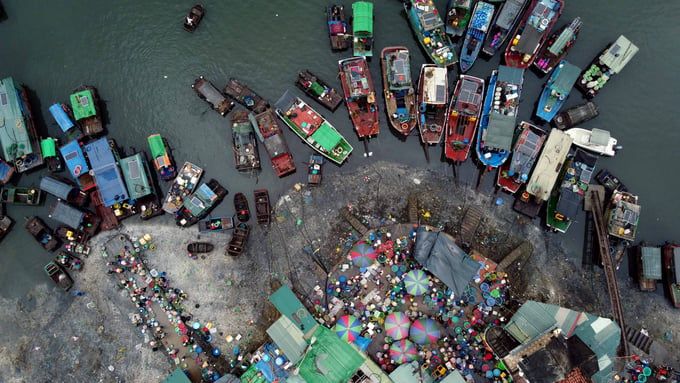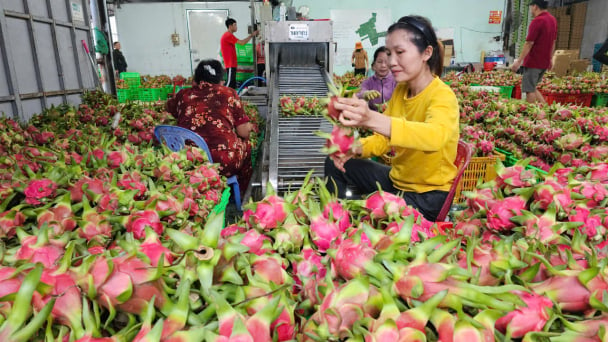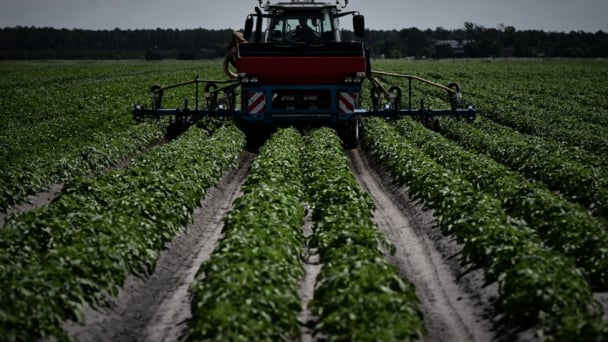June 17, 2025 | 16:49 GMT +7
June 17, 2025 | 16:49 GMT +7
Hotline: 0913.378.918
June 17, 2025 | 16:49 GMT +7
Hotline: 0913.378.918
Director of D-Fish Tran Dinh Luan shared that around the end of March and the beginning of April in 1959, President Ho Chi Minh visited fishing villages and fishermen in Tuan Chau islands, Cat Ba, where he urged: “Our silver sea owned by our people”. His teachings reflect the grand ideology about the boundless potential of the maritime economy and ignite awareness of protecting the sovereignty of the sea, the sacred islands of the Fatherland. Following the aspirations of the fisheries sector and numerous fishermen, April 1 of each year was officially designated as Vietnam's Fisheries Tradition Day by the Prime Minister's decision.

The lonstanding tradition and the continuous persistent effort have fostered all staff, fishermen and labors in the fisheries sector gradually overcome difficulties, challenges to expand the fisheries sector from a small production field to a key economic sector with high growth rate. It also contributes to the improvement of economic, social and cultural life of fishermen, and significantly to maintaining security, protecting the sovereignty of the homeland's seas and islands.
Over the past 65 years, the fisheries sector has undergone development and integration, experiencing four main stages with notable achievements as follows:
The first stage (from 1959 to 1975)
It was a period marked by war in the country, during which officials and fishermen in the fisheries sector, along with the entire nation, carried out two strategic tasks: "Building the Socialist Republic in the North and defeating the American enemy, liberating the South." In this challenging period, in 1960, the Directorate of Fisheries under the Ministry of Agriculture and Forestry was established.
During this stage, the cooperative economy played a significant role in marine fishing. Through the cooperative movement, the fishing industry adopted new technologies, mechanized fishing boats, and introduced nylon fishing nets. Vietnamese-Soviet, Vietnamese-Chinese, Vietnamese-German, and Vietnamese-Korean fishing fleets were established, and canning factories such as Ha Long Canned Fish Factory, Ha Long Mechanical Factory, and Vat Cach Mechanical Factory were established, laying the initial foundation for the Vietnamese fishing industry. The annual catch of marine fish during the period from 1960 to 1965 reached 110,000 to 130,000 tons. Despite the wartime conditions from 1966 to 1975, the annual catch of marine fish still reached 60,000 to 100,000 tons.
Since 1963, fisheries scientists have successfully bred artificial breeds of bighead carp, carp, grass carp, mrigal, tilapia. The initial success in producing artificial shrimp seeds opened up prospects for the strong development of aquaculture in the future. Also in 1963, products from the Ha Long Canned Fish Factory were exported. In 1971, Vietnam's first frozen seafood products were exported to the regional market (Japan, Singapore, Hong Kong).
The second stage (from 1976 to 1986)
The period witnessed the imperative need for the development of marine fishing. In the first session of 1976, the unified Vietnamese National Assembly established the Ministry of Marine Products. In 1981, this ministry was reorganized into the Ministry of Fisheries.
This period marked a significant transformation for the fisheries sector in the context of national reunification. The fisheries economy began to be carefully developed to transform it into a technically advanced economic sector.
In the initial stage, due to the heavy consequences of war and inappropriate management mechanisms, production incentives for fisheries were limited. The fisheries economy declined significantly due to the outdated management practices focusing solely on the quantity of products, neglecting their value.
However, from 1981, after the establishment of the Vietnam Seaprodex Corporation, which was allowed by the state to experiment with the "self-balancing, self-financing" mechanism, essentially emphasizing the enhancement of the value of products to generate investment sources for expansion and reproduction, the fisheries sector began to experience robust development. In the 1980s, fisheries were considered one of the pioneering sectors in the process of renovation, transitioning towards a market-oriented economy under the socialist direction in Vietnam. The new path for the sector was opened up like a voyage into the vast ocean.
The third stage (from 1986 to 1995)
Following the previous strong development phase, the period witnessed significant strides and comprehensive growth in the fisheries sector amidst international integration.
During this period, non-state economic models were encouraged, attracting various economic components and promoting investment for development, contributing to strengthening the individual fisheries sector.
The total fisheries production surpassed the threshold of 1 million tons in 1990. Export-oriented shrimp farming was identified as a crucial breakthrough, with other aquaculture species becoming increasingly diverse, including freshwater, brackish water, and marine aquaculture.
From the mid-1990s, the fisheries sector focused on innovating quality and safety management methods for products, gradually meeting the demands of major markets. As a result, Vietnamese seafood products gained credibility and stood firm in the world's largest seafood markets.
In 1995, the total fisheries production reached 1.34 million tons, with 928.8 thousand tons from capture fisheries and 415.3 thousand tons from aquaculture. The export revenue reached 550 million USD. During the period from 1980 to 1990, the fisheries export turnover increased by an average of 48.29% per year. By the period from 1991 to 1996, the export growth rate remained at 15.97% per year.
The fourth stage (from 1995 to the present)
The stage has seen comprehensive and robust development in the fisheries sector.
In 2007, the Ministry of Fisheries merged with the Ministry of Agriculture and Rural Development. In March 2010, the Prime Minister decided to establish the Directorate of Fisheries under the Ministry of Agriculture and Rural Development. In April 2014, the fisheries inspection force was established.

Vietnam's fisheries sector has built a solid and systematic foundation to aim for larger goals, contributing to providing a cornerstone for the development of the entire country. Photo: Hong Tham.
This period has witnessed remarkable transformations in fisheries production and business operations towards enhancing capacity, expanding production and business scales, creating numerous jobs, and increasing income for fishermen nationwide, thereby generating significant revenue for the state budget.
The fisheries sector has proactively led in international integration, promoting the application of advanced science and technology in production, linking raw material production with processing, trade promotion, and expanding export markets.
After 20 years of comprehensive development, the fisheries sector has made significant breakthroughs. Fisheries production in 2023 reached over 9.3 million tons, 7.1 times higher than in 1995, with aquaculture reaching 5.5 million tons, more than 5 times higher than in 1995. There has been a positive shift in the structure of fisheries production, with the proportion of aquaculture increasing from 31% in 1995 to nearly 57% in 2023.
With dynamism, creativity, and overcoming various challenges, Vietnamese seafood products have been exported to more than 170 markets. The export turnover exceeded USD1 billion for the first time in 1999 and nearly USD11 billion in 2022, placing Vietnam in the third position among the world's largest seafood exporting countries (after China and Norway).
In recent years, the fisheries sector has always garnered attention from the Party, Government, and Prime Minister, with numerous policies and directives issued to support its development:
Resolution No. 36-NQ/TW of the Central Committee of the Communist Party (12th Tenure) on the sustainable development strategy of Vietnam's marine economy until 2030, with a vision to 2045, sets the goal of making Vietnam a strong maritime nation, rich in marine resources. It aims to achieve basic criteria for sustainable development of the marine economy, form marine ecological cultures, proactively adapt to climate change and sea level rise, prevent pollution trends, environmental degradation, coastal erosion, and marine encroachment, restore and preserve important marine ecosystems. New scientific, advanced, and modern achievements become direct factors driving sustainable development.
The fisheries sector has also been approved by the Prime Minister for the Strategy for the Development of Vietnam's Fisheries until 2030, with a vision to 2045. This strategy defines the viewpoint of building fisheries into an economic sector with a large scale and high commodity rate, having reputable brands, deeply participating in global supply chains, with high competitiveness and sustainability. By 2045, fisheries will be a modern, sustainable commercial sector, a center for deep-sea seafood processing, among the top three seafood producing and exporting countries globally. It will maintain its significant position in the structure of agricultural and marine economies, contributing to ensuring food security, social welfare, clean and beautiful fishing villages, with fishermen's incomes equal to the national average, contributing to national defense, security, and safeguarding the homeland's maritime sovereignty.
Fishermen residing in coastal regions have historically exploited natural resources strategically, capitalizing on the sea's potential to sustain their livelihoods and safeguard the maritime sovereignty of their nation. This tenacity is exemplified by the Hoang Sa Fleet.
Translated by Linh Linh
![Turning wind and rain into action: [6] ‘Four on-the-spot’ disaster management software](https://t.ex-cdn.com/nongnghiepmoitruong.vn/608w/files/news/2025/06/14/z6705183772518_8e6a71d5e2d464e10197411eb1d14b51-nongnghiep-192556.jpg)
(VAN) By simply activating the scenario on the disaster management software, the relevant authorities immediately know how many households need to be evacuated, where to evacuate them to, and by what means of transportation…

(VAN) According to the Binh Thuan Department of Industry and Trade, in the first five months of 2025, Binh Thuan's dragon fruit export turnover increased by 20.65% compared to the same period last year.

(VAN) EU countries on Thursday gave final approval to new tariffs on fertilizer imports from Russia, a move aimed at cutting off revenue that could support Moscow’s war in Ukraine, despite concerns from European farmers.

(VAN) The working delegation from the Ministry of Agriculture and Environment conducted an important trip to the Netherlands to strengthen strategic partnerships and sustainable development in the agricultural sector.

(VAN) The letter ‘A Plea from the Ocean’ not only evokes emotion but also awakens the human conscience to the responsibility of protecting life on Earth.

(VAN) The Department of Agriculture in South Africa has announced the country’s first mass vaccination of poultry to prevent local birds from contracting avian influenza.

(VAN) Establishment of the Mekong Delta Regional Agricultural Linkage Center, aiming for a closed value chain, deep processing, trading platforms, and international market connectivity.